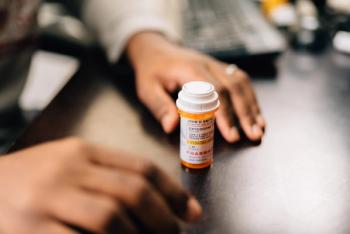
- November 2009
- Volume 75
- Issue 11
First Person: Matthew Levanda on Medication Reconciliation
Ms. Wick is a senior clinical research pharmacist at the National Cancer Institute, National Institutes of Health, Bethesda, Maryland. The views expressed are those of the author and not those of any government agency.
“Many health care providers are lousy communicators, and that makes medication reconciliation an incredible challenge,” said Matthew Levanda, RPh, MBA, director of pharmacy services at Bayshore Community Hospital in Holmdel, New Jersey. “Although medi-cation reconciliation is nothing new—we have been doing it for select patients for years—now, it is required all the time. And although hospitals may in the past have communicated to community-based clinicians, perhaps reluctantly, this [Joint Commission] initiative means we are communicating all the time.”
The Joint Commission on Accreditation of Health Care Organizations (JCAHO) mandate came to fruition after analysis of its sentinel event database revealed that more than 350 medication errors resulted in death or major injury. Root-cause analysis identified complete or partial communication breakdown as a significant contributor in 63% of cases, confirming Levanda’s “lousy communicators” hypothesis.
Since 2006, JCAHO has required medication reconciliation (MR), believing it will minimize some of the ~1.3 million iatrogenic adverse events that occur annually, many related to medication. MR effectively prevents loss of medication information as patients transfer among community-based and hospital providers. It may prevent up to 70% of all potential errors and 15% of all adverse drug events.1
In talking with Levanda, it became apparent that he has been able to confront medication reconciliation’s trials and tribulations with a sense of urgency and a push for efficiency. At his 225-bed facility, pharmacists have worked in concert with the facility’s interdisciplinary staff—a step he identifies as key to success. Levanda and Bayshore’s interdisciplinary team began establishing an MR process in 2006; today, that process continues, with constant tweaking in response to scheduled, ongoing audits.
Different health systems approach MR differently. Initially, Bayshore developed its process using Failure Mode and Effect Analysis (FMEA), which looks at a proposed process pro- spectively, searching for failure points. FMEA minimizes the possibility of failure. Levanda indicated they also “backed into” the process, starting at the patient. They asked questions that revealed different types of patients and their locations in the system and levels of care, and they identified patient transfer points for mandated MR. This met JCAHO’s stipulation that MR occur at all care interfaces, also known as “hand-offs,” and upon admission to and discharge from ambulatory, emergency and urgent care, long-term care, or home or inpatient services.2
Despite FMEA, Bayshore’s process was imperfect at the start. Internally, Bayshore gave primary responsibility for MR to nursing as an assessment function, during which nurses were to create a handwritten list of all medications.
Levanda praised the system’s design, saying, “Any performance improvement system has to be flexible and reactive. Soon after we started our MR process, we realized that allowing the nursing assessment to be completed in 24 hours meant that the pharmacy might not receive the MR report until after the attending physician had changed the patient’s medication orders more than once. We had to revamp the process, shave 16 hours off nursing’s allowable time, and ask that it be done within the 8-hour shift.”
The short time frame complicated an already difficult process, but the nurses rose to the occasion. Patients tend to be poor historians—all pharmacists have heard a line like this all too often: “I take a blue pill for my pressure, or maybe my diabetes”—and the MR form identifies the source of the information so that its reliability can be judged. Occasionally, the staff has to call a community pharmacy for information when patients simply do not know what they take.
Some admissions proved to be more of a hurdle than internal transfers, especially among elderly clientele. Approximately 90% of Bayshore’s admissions come through its emergency department, and many elderly patients arrive unprepared to discuss their medications. Those who come from nursing homes usually present with a copy of their Medication Administration Record (MAR). Levanda said, “Every initiative has a point that makes or breaks it, and one particular nursing home admission made our MR process. A patient arrived in the emergency room with an MAR from her nursing home, and it looked like she had 23 active medications. The nurse who called the facility to conduct MR found that only 6 of the 23 were active. It was a seminal moment when we realized that, before MR, the patient would have been given 23 medications—incorrectly. For our staff, the lightbulb went off.” He went on to say that communicating success stories like these helps galvanize quality improvement initiatives.
Participant Buy-in
With the volume of paperwork being a constant complaint among health care providers, Bayshore used the MR process to modify paperwork requirements, promoting staff buy-in. Levanda explained, “We consolidated several forms, reduced paperwork, and incorporated this into our admission process.” In addition, the names, addresses, and phone numbers of every pharmacy within a 5-mile radius of the hospital are compiled to facilitate information retrieval when necessary. Although the initial MR form is handwritten, all subsequent transfer and discharge forms are automated and differentiate active and inactive medications.
The process has uncovered an occasional surprise. Bayshore found that its compliance with MR declined during one quarterly reporting period. Investigation revealed that a new service had been created, but an oversight had allowed the service to circumvent the MR process. They educated staff and implemented MR immediately.
As is the case with all forms, health care providers are not always perfect in following instructions. At Bayshore, staff tends to be diligent recording dose, route, and frequency but omit the time when the last dose was taken. Feedback from auditors to offending clinicians is intended to improve this area.
At discharge, Bayshore provides a current list of medications to each patient and faxes it to the next primary care, specialty, or long-term care provider. Since many patients do not understand medical abbreviations, their copy is accompanied by an explanation of abbreviations used.
When asked about confidentiality, Levanda was quick to point out that exchange of health care information between providers about shared patients violates no law. He said that over time, clinicians who work at Bayshore develop relationships with community-based clinicians, and care has improved as a result. Practice has made the process brutally efficient, and its efficiency and demonstrated value have increased its worth to those who conduct the process.
Articles in this issue
almost 16 years ago
Case Studiesalmost 16 years ago
Rx Abuse in Rural Americaalmost 16 years ago
Health Systems Pharmacy Product Newsalmost 16 years ago
Can You Read These Rxs?almost 16 years ago
OTC Product Newsalmost 16 years ago
MTM Session: Targeting the Common Coldalmost 16 years ago
Are We Using Controlled Substances Properly?almost 16 years ago
Otic Disordersalmost 16 years ago
COMPOUNDING HOTLINE Your Compounding Questions Answeredalmost 16 years ago
Women's Health WatchNewsletter
Stay informed on drug updates, treatment guidelines, and pharmacy practice trends—subscribe to Pharmacy Times for weekly clinical insights.





















































































































































































































